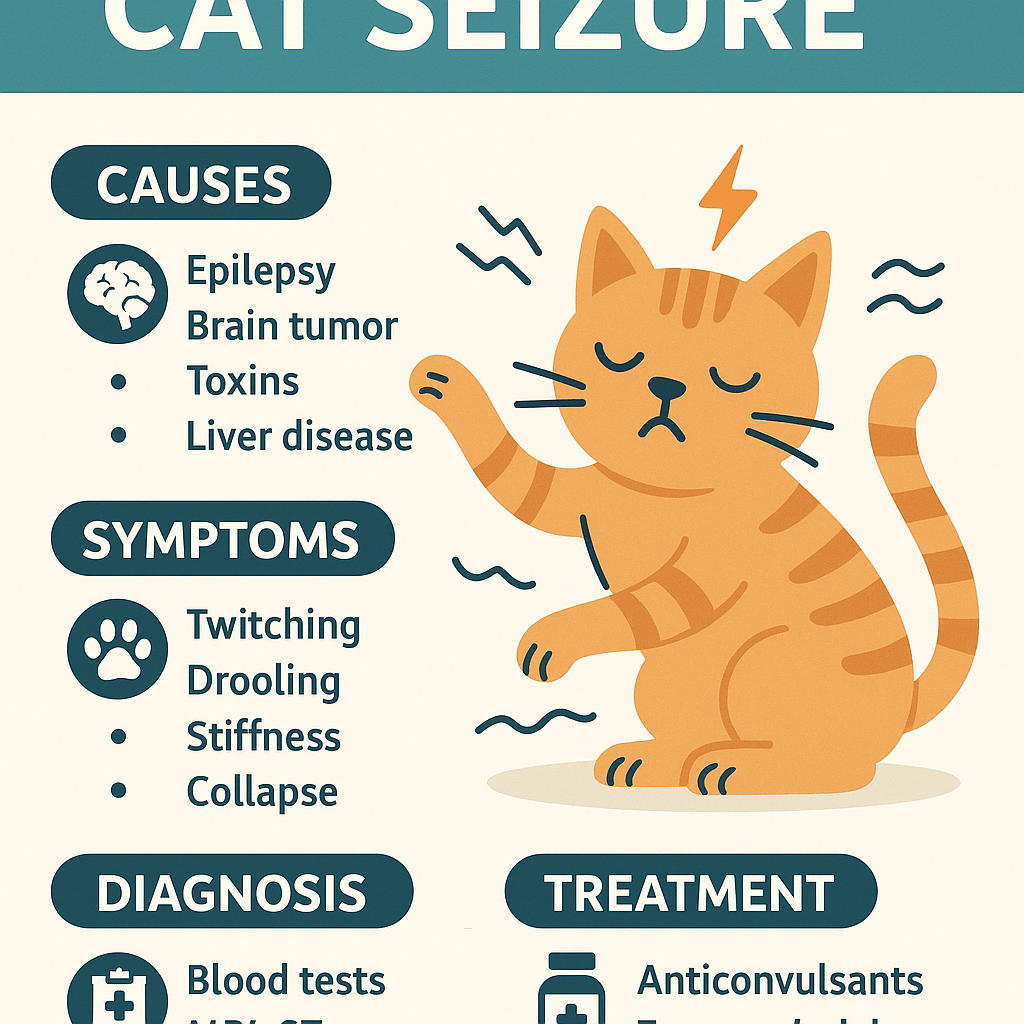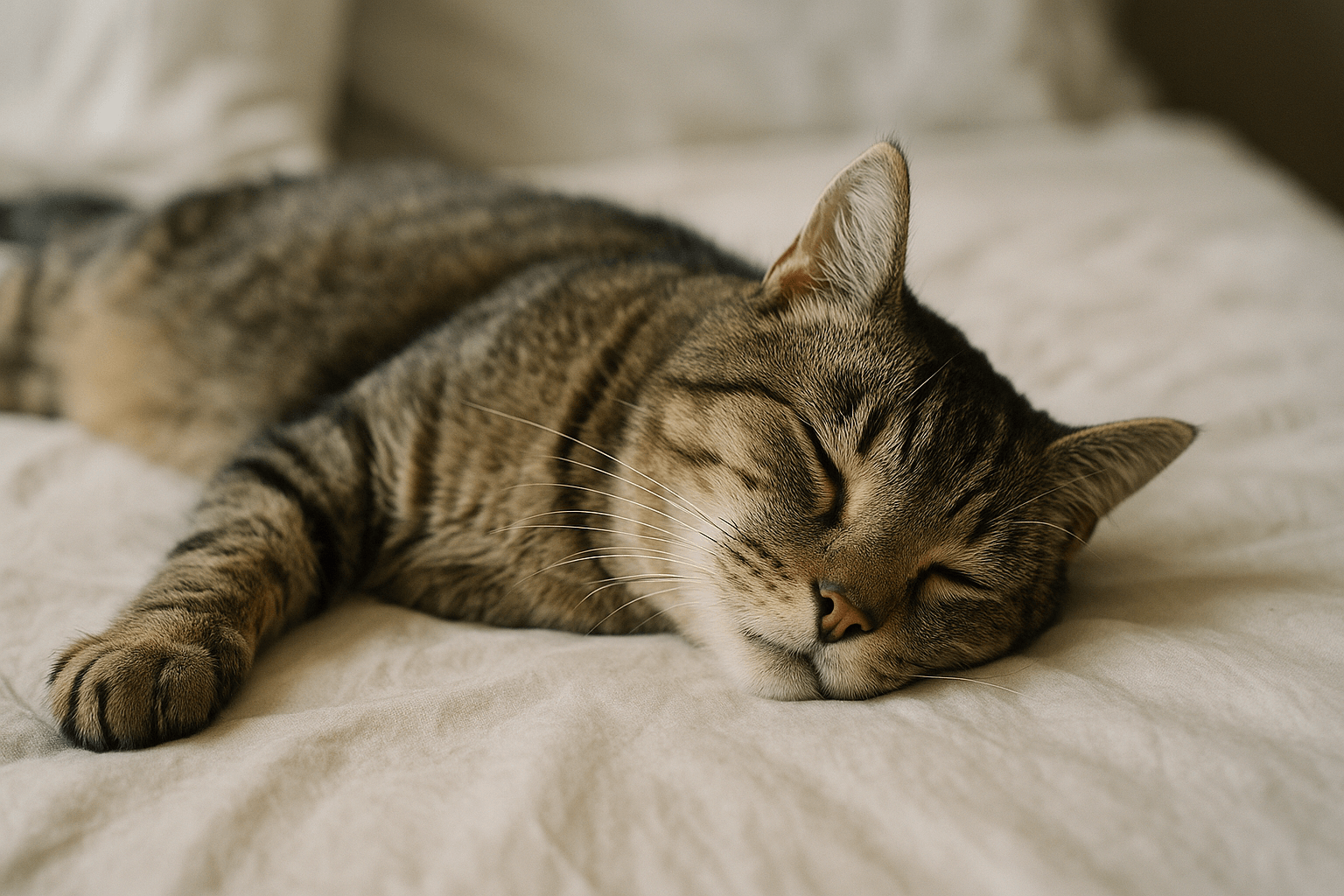Understanding Cat Seizures: What Every Pet Owner Should Know
Witnessing a cat seizure can be a frightening and confusing experience for any pet owner. While seizures in cats are less common than in dogs, they can still occur and may indicate underlying health issues that require immediate attention. A seizure is essentially an abnormal burst of electrical activity in the brain, leading to temporary changes in behavior, movement, or consciousness. Understanding the causes, symptoms, and treatment options for cat seizures is crucial for ensuring your feline companion receives the care they need. In this blog post, we’ll explore everything you need to know about cat seizures, from recognizing the signs to managing the condition effectively.
Expert Insight on Cat Seizures
“A seizure is defined as a sudden, uncontrolled electrical disturbance in the brain that can lead to behavioral changes and a change in levels of consciousness. Seizures of any kind are frightening to watch, especially when they happen to our feline friends. In general, seizures themselves are usually not life-threatening unless they are violent or prolonged.”
Common Causes of Cat Seizures
Cat seizures can stem from a variety of factors, ranging from medical conditions to environmental triggers. Identifying the root cause is essential for proper diagnosis and treatment.
Epilepsy:
Idiopathic epilepsy, while rare in cats, can cause recurrent seizures without a clear underlying cause.Toxins or Poisoning:
Exposure to toxic substances like antifreeze, certain plants, or household chemicals can trigger seizures in cats.Brain Tumors or Trauma:
Growths or injuries in the brain may disrupt normal electrical activity, leading to seizures.Infections:
Feline infectious diseases, such as feline leukemia virus (FeLV) or toxoplasmosis, can affect the nervous system and cause seizures.Metabolic Disorders:
Conditions like diabetes, liver disease, or kidney failure can lead to imbalances that trigger seizures.
Understanding these potential causes helps pet owners take proactive steps to protect their cats and seek timely veterinary care when needed.

Recognizing the Symptoms of a Cat Seizure
Identifying a seizure early can make a significant difference in managing your cat’s health. Here are some common signs to watch for if you suspect your cat is experiencing a seizure.
Sudden Collapse or Loss of Consciousness:
Cats may fall over or appear unresponsive during a seizure episode.Uncontrolled Movements:
Twitching, paddling motions with the legs, or jerking movements are hallmark signs of a seizure.Drooling or Foaming at the Mouth:
Excessive salivation or foaming is often observed during a seizure.Vocalization or Agitation:
Some cats may yowl, meow loudly, or exhibit signs of distress before or during a seizure.Post-Seizure Confusion:
After the seizure, cats may seem disoriented, lethargic, or temporarily blind.
By familiarizing yourself with these symptoms, you can act quickly and provide your cat with the care and support they need during and after a seizure.
Check this guide 👉Cat Epilepsy Treatment: Best 7 Health Tips!
Check this guide 👉Are Cats or Dogs Smarter? Best 7 Expert Tips!
Check this guide 👉Convenia Injection for Cats: Best 7 Expert Tips!
Signs of a Cat Seizure | Possible Causes to Investigate |
|---|---|
Sudden collapse | Brain tumor or trauma |
Uncontrolled twitching or jerking | Epilepsy or poisoning |
Drooling or foaming at the mouth | Toxic exposure or metabolic disorder |
Vocalization or agitation | Pain, stress, or infection |
Post-seizure confusion | Neurological or systemic issues |
What to Do During a Cat Seizure
If your cat experiences a seizure, it’s important to stay calm and take specific steps to ensure their safety. Here’s what you should do during and immediately after a seizure episode.
Stay Calm and Observe:
Avoid panicking and carefully monitor the duration and intensity of the seizure.Protect Your Cat from Injury:
Clear the area around your cat to prevent them from bumping into objects or falling off furniture.Do Not Restrain Your Cat:
Attempting to hold your cat down can cause harm. Let the seizure run its course naturally.Time the Episode:
Use your phone or a timer to track how long the seizure lasts. Episodes lasting more than 5 minutes require emergency veterinary care.Comfort Your Cat Afterward:
Once the seizure ends, gently reassure your cat and keep them in a quiet, safe space to recover.
Taking these steps ensures your cat remains safe and minimizes stress during a seizure episode.
Diagnosis and Treatment Options for Cat Seizures
If your cat has experienced a seizure, consulting a veterinarian is essential to determine the underlying cause and develop an appropriate treatment plan.
Comprehensive Physical Exam:
A thorough examination helps rule out external factors like toxins or injuries.Blood Tests and Urinalysis:
These tests check for metabolic disorders, infections, or organ dysfunction.Imaging Studies:
X-rays, MRIs, or CT scans may be used to detect brain tumors, trauma, or structural abnormalities.Medication Management:
Anti-seizure medications, such as phenobarbital, may be prescribed to control recurrent seizures.Lifestyle Adjustments:
Reducing stress, avoiding toxins, and maintaining a healthy diet can help manage seizure triggers.
With proper diagnosis and treatment, many cats with seizures can live happy, fulfilling lives.
Preventive Measures to Reduce Seizure Risks
Preventing seizures in cats starts with minimizing potential triggers and maintaining their overall health. Here are some practical steps to reduce the risk of seizures in your feline friend.
Keep Toxic Substances Out of Reach:
Store cleaning products, medications, and plants safely to prevent accidental poisoning.Provide a Balanced Diet:
Feed your cat high-quality food to support brain and nervous system health.Minimize Stressful Situations:
Create a calm environment by reducing noise, providing hiding spots, and maintaining a predictable routine.Schedule Regular Vet Checkups:
Routine exams help catch underlying health issues before they escalate into serious problems.Monitor for Early Warning Signs:
Pay attention to subtle changes in behavior or health that could indicate an impending seizure.
Taking these preventive measures can significantly lower the likelihood of seizures and promote your cat’s long-term health.
How to Support Your Cat After a Seizure
Caring for your cat after a seizure involves both physical and emotional support. These steps can help your cat recover and feel secure following an episode.
Offer Fresh Water and Food:
Ensure your cat has access to water and a light meal to replenish their energy.Provide a Quiet Space:
Allow your cat to rest in a peaceful area away from loud noises or disturbances.Avoid Overstimulation:
Refrain from petting or engaging too much until your cat seems fully recovered.Monitor Their Behavior:
Keep an eye on your cat for any unusual symptoms or recurring seizures.Follow Up with Your Vet:
Schedule a follow-up appointment to discuss ongoing care and adjustments to treatment plans.
By prioritizing your cat’s recovery, you can help them regain their strength and confidence after a seizure.
Emotional Impact on Pet Owners
Experiencing a cat seizure can be emotionally taxing for pet owners, often leaving them feeling overwhelmed or anxious. Here are some tips to cope with the emotional impact of caring for a cat with seizures.
Educate Yourself:
Learning about seizures empowers you to make informed decisions and reduces feelings of helplessness.Seek Support from Others:
Connect with online communities or local pet groups to share experiences and advice.Practice Self-Care:
Take breaks and prioritize your own mental health to stay strong for your cat.Focus on Positive Moments:
Celebrate small victories and cherish the joyful times you share with your cat.Trust Your Instincts:
You know your cat best—trust your intuition when advocating for their care and well-being.
By addressing your emotional needs, you can better support your cat and maintain a positive outlook throughout their journey.
Frequently Asked Questions About Cat Seizures
What should I do if my cat has a seizure?
Stay calm, protect your cat from injury, and time the seizure. Contact your vet immediately if it lasts more than 5 minutes.
Can seizures be cured in cats?
While some causes of seizures can be treated or managed, others may require lifelong medication and monitoring.
Are seizures painful for cats?
Seizures themselves are not typically painful, but the post-seizure confusion can cause discomfort or anxiety.
How can I prevent my cat from having another seizure?
Follow your vet’s recommendations, avoid known triggers, and maintain a consistent routine to reduce stress.
When should I see a vet for a seizure?
Seek veterinary care if your cat has a seizure lasting longer than 5 minutes, experiences multiple seizures in a short
Supporting Your Cat Through Seizures
While cat seizures can be alarming, understanding their causes, symptoms, and treatment options allows you to provide the best possible care for your furry friend. By staying vigilant, working closely with your veterinarian, and creating a safe environment, you can help your cat navigate this challenging condition. Remember, your love and dedication play a vital role in ensuring your cat’s comfort and well-being. With the right approach, you can give your feline companion the support they need to thrive despite seizures.
Why Is My Cats Second Eyelid Showing? Understanding the Nictitating Membrane Your cat blinks slowly… then you notice it — a …
How Do I Know If My Cat Died Peacefully? Best 7 Expert Tips! Discover the quiet signs of a peaceful feline passing and find comfort in their final moments.
How Do I Know If My Cat Died Peacefully? A Gentle Guide for Heartbroken Owners Losing a cat is not just …
Why Do Abyssinian Cat Colors Matter? Best 7 Expert Tips! Discover the genetics, rare hues, and care secrets behind Abyssinian coat colors for a healthier, happier cat.


